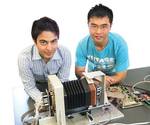Concertina music has robotic overtones
A group of Mechanical Engineering graduates and their supervisor will fly to France this month, accompanied by a highly unusual piece of luggage. The 2008 Masters students and Dr Steven Grainger hope their computer-operated musical concertina will impress the judges at an international competition in Nice on Thursday 23 April for machines that play musical instruments. Mohsen Bazghaleh, Yudi Wang, Long Xin, Jia You, Chen Fei Yu and Yin Yuan spent their final year at university designing a 48-key robotic concertina. The instrument won the national competition, the Candiago Cup Challenge, in 2008 and now qualifies for the international Artemis Orchestra Competition. It is the second time that the University's mechanical engineering school has been represented at the Artemis competition, earning second place in Berlin in 2007 with a robotic violin design. Supervisor Dr Grainger, a lecturer in the School of Mechanical Engineering, said the concertina was controlled by a microprocessor-based system. "The microprocessor drives the bellows via an electric motor and uses feedback to control the air pressure. It also operates electromechanical wires that open and close valves, letting air flow over the sound-producing reeds," Dr Grainger said. All the skills developed during the project, including the mechanical, software and electronic design, are directly applicable to the real world of mechanical engineering. "Graduate students might be expected to design similar systems for hard disk drives, automotive anti-lock braking systems or manufacturing robotics," he said. The robotic concertina project formed part of a Masters course in Advanced Digital Control taught by Dr Grainger. The course is concerned with the design and analysis of devices controlled by computers. The concertina was invented in 1829 by British scientist, Sir Charles Wheatstone, more famously known for the Wheatstone Bridge, an electric circuit used for measuring unknown resistances. Story by Candy Gibson
|





